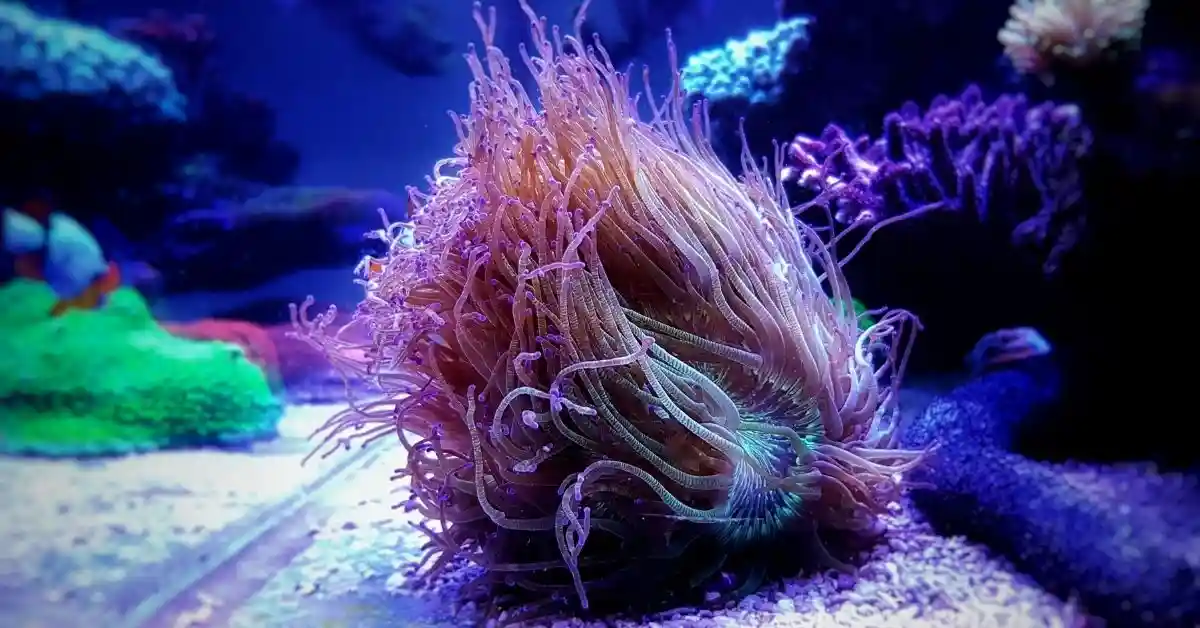It has been a long time since you purchased an elegance coral, but it is still not opening.
Don’t worry; we’ve got your back. We have an article that will provide you with all of the information you need to care for your elegance coral.
Why your elegance coral is not opening?
Elegance coral is an excellent choice. It is quite simple to care for. Elegance is a delicate coral. This exquisite coral resembles an anemone and has long, flowing tentacles.
Even though it is connected to frogspawn, torch, and hammer corals rather than starfish, however, elegant coral must be handled carefully, or it will not open.
Let’s examine why elegant coral is not opening in an aquarium!
Why is Elegance Coral Not Opening?
Catalaphyllia Jardine, often known as Elegance Coral, is a beautiful and ecologically different species that may be found either as a single polyp or within a colony.
Let’s take a look at why the elegance coral isn’t opening. There are several reasons why your elegance coral may malfunction.
First and foremost, there might be an issue with their ecology, the location of the coral in the aquarium.
Whether it is getting enough light or not, and also the water flow in the aquarium is correct or not.
Let’s go through this in more depth.
Elegance Coral’s Optimal Ecosystems
These magnificent crustaceans may be found around the world in the Barrier Reef in Australia, as well as places near Japan, Vanuatu, Micronesia, and Mozambique.
They reside in the deeper and mid-range areas of the reed, not venturing above 130 feet which is 40 meters.
They are generally always found in mudflats of lakes and seagrasses.
The elegance coral is ideally suited to larger tanks, approximately 90-100 gallons (341-379L) in size, since it will grow to a pretty large size if healthy.
However, this is assuming that you want to retain this coral together with numerous other kinds.
If you want to maintain this coral in a smaller tank, make it the center point and give it lots of space to flourish.
You must ensure that fundamental reef water requirements are followed. Elegance corals thrive in conventional aquarium salt combinations.
Placement
Elegance corals might grow to be 12 by 8 inches which are 30.520.3 centimeters in size in adulthood.
However, the filaments extend an additional 6 inches, which is 15.2 centimeters.
To summarize, it is a relatively large coral that you must consider while putting it in the aquarium.
Sweeper tentacles, which specialize in stinging and destroying, are also seen on Elegances.
If you want to avoid coral attacks in your aquarium, give this coral a wide berth and plenty of room to grow.
The elegance coral is resilient and very easy to care for, making it an appealing addition to the ordinary reef aquarium.
Elegance corals, like most other LPS corals with big, plump polyps, thrive in mild water flow.
Increasing water flows will keep the tentacles retractable and tiny. In the worst-case scenario, they will be destroyed and torn.
They live on soft, shallow loam in the wild. If you would like to mimic its native surroundings in terms of soil and illumination, place the specimen near the surface of the water on perfectly alright sands.
It is not the only area where they may be kept. Trying to attach them to live rock has shown to be successful for many aquarists.
That being stated, they must be put in a section of your aquarium where they will get a medium flow and unobstructed accessibility to medium sunlight.
Lighting:
Elegance corals need a relatively high level of light to maintain photosynthesis.
However, this does not imply a lot of light. LEDs, fluorescent lights, or any reef-safe lighting will suffice.
You should strive for a PAR of 80-120. PAR is a term for Photosynthetically Available Radiation, which is used to examine the effectiveness of the light.
Flow
Water flow is critical in any aquarium that contains corals. Because elegances have huge meaty polyps, Mild is the essential description here.
You don’t want the flow to be too harsh or too gentle.
Elegance corals will not flourish if there is insufficient light. If you have too much flow, you risk damaging the tiny polyps.
The proper flow ensures that nutrients reach the polyps and that they continue to stay nourished.
As they float in the river, you’ll see the classic “sweeping” action. You don’t want a cyclone, but rather a dramatic sweep.
Elegance Coral Feeding
The elegance coral is capable of photosynthesis, which implies that mutualistic photosynthetic phytoplankton is called zooxanthellae.
It keeps living inside its body cells and provides nutrition by collecting light energy – similar to a plant. Regular feedings are also beneficial to them.
Soft, fleshy feeds will be eagerly accepted by your coral.
Quark, Mysis shrimp, brine shrimp, and tiny bits of fish, shrimp, or oysters are prominent meals.
The size of this coral should be fed with caution. High-quality meals that are relatively tiny in size are preferred.
Huge foods may be avidly accepted by an elegance coral, but it may be rehashed later if it is too large to enter the digestive system.
Elegance Coral Suggestions and Advice
Here are several elegance coral tips if you are contemplating introducing an elegance coral to your aquarium:
Before purchasing, take a close look at the soft corals.
Avoid purchasing a specimen with polyps that have been damaged in transport.
These corals do not always heal from significant injury.
Remember that corals are animals, not plants, and also corals enjoy eating.
To ensure optimum development, nourish it regularly.
Give it room to develop. Even if it’s a year or two away, ensure that it is far away and that it can’t hurt its neighbors.
FAQs
Question: How long does it take Coral to open?
Answer: Corals open up in around two days on average.
Question: Do elegance corals shut down at night?
Answer: retracts at night.
Question: Is it okay if I dip an elegant coral?
Answer: Dipping elegance coral or other LPS corals that arrive in poor condition.
Final Words
That was all about why elegance coral is not opening. I hope this clarifies all of your questions.
If you have any additional queries regarding this, please contact us through email.

